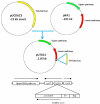Pseudomonas fluorescens HK44: lessons learned from a model whole-cell bioreporter with a broad application history
- PMID: 22438725
- PMCID: PMC3304127
- DOI: 10.3390/s120201544
Pseudomonas fluorescens HK44: lessons learned from a model whole-cell bioreporter with a broad application history
Abstract
Initially described in 1990, Pseudomonas fluorescens HK44 served as the first whole-cell bioreporter genetically endowed with a bioluminescent (luxCDABE) phenotype directly linked to a catabolic (naphthalene degradative) pathway. HK44 was the first genetically engineered microorganism to be released in the field to monitor bioremediation potential. Subsequent to that release, strain HK44 had been introduced into other solids (soils, sands), liquid (water, wastewater), and volatile environments. In these matrices, it has functioned as one of the best characterized chemically-responsive environmental bioreporters and as a model organism for understanding bacterial colonization and transport, cell immobilization strategies, and the kinetics of cellular bioluminescent emission. This review summarizes the characteristics of P. fluorescens HK44 and the extensive range of its applications with special focus on the monitoring of bioremediation processes and biosensing of environmental pollution.
Keywords: Pseudomonas fluorescens HK44; bioluminescence; bioreporter; biosensors; lux genes.
Figures






References
-
- Leveau J.H.J., Lindow S.E. Bioreporters in microbial ecology. Curr. Opin. Microbiol. 2002;5:259–265. - PubMed
-
- van der Meer J.R., Belkin S. Where microbiology meets microengineering: Design and applications of reporter bacteria. Nat. Rev. Microbiol. 2010;8:511–522. - PubMed
-
- King J.M.H., Digrazia P.M., Applegate B., Burlage R., Sanseverino J., Dunbar P., Larimer F., Sayler G.S. Rapid, sensitive bioluminescent reporter technology for naphthalene exposure and biodegradation. Science. 1990;249:778–781. - PubMed
Publication types
MeSH terms
LinkOut - more resources
Full Text Sources

